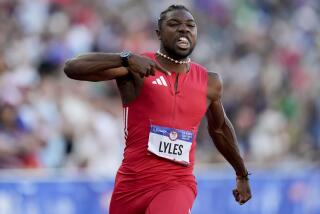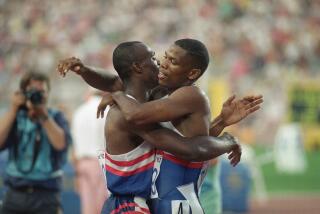Atkinson Is Ready to Take Step Toward a National Crown : Track: Former Mira Costa High runner battles back from injury to compete for TAC 1,500-meter title.
- Share via
Jeff Atkinson is back in town this weekend to compete in The Athletics Congress Track and Field Championships at Cerritos College and the 27-year-old can’t wait to take a jog on his old training route, the Strand in Manhattan Beach.
Perhaps a dose of hometown, ocean air can help the Mira Costa High graduate win his first TAC national 1,500-meter title, but the 1988 Olympian and Stanford All-American willhave to overcome two big obstacles.
The first is an ankle injury that has hampered his training all year. The second is that he will compete against a tough field at Cerritos, including veteran miler Steve Scott and two-time NCAA champion Joe Falcon.
All three men are expected to cruise through Friday night’s preliminary heat and advance to Saturday’s final at 8:25 p.m. The top two finishers will go to the Goodwill Games in Seattle July 23-26.
“Up to four weeks ago he told me he was definitely going to be in Seattle so I already bought tickets for the family for Seattle,” said Atkinson’s father, Willie Atkinson, who lives in Manhattan Beach.
Last year Atkinson was the TAC’s top-ranked miler, Falcon was No. 2 and Scott No. 3. This year’s rankings won’t be released until the end of the year, after all major competition is completed, but Atkinson believes Falcon has taken over as the top-ranked miler.
Falcon, 24, was the 1988 NCAA 1,500 champion and the 1987 NCAA 10,000 champion.
Scott, 34, was the country’s premier miler in the 1980s. He’s won the TAC 1,500 title six times and has been ranked in the top 10 since 1976.
Atkinson is confident of a good finish despite the injury and strong competition. In November of 1989, he tore ligaments in his left ankle after stepping on a rock while running in Los Altos, where he lives and trains.
He shares a large house called “The Training Manor” with indoor 800 champion Ray Brown, steeplechaser Dave Frank and TAC 10-kilometer road champion Harry Green, a former All-American at the University of Texas.
“It took me three months to get back into running condition,” Atkinson said. “I’ve been unable to train properly and I don’t think I’ll be as prepared as I have been in the past. But I like to run well when it counts. . . . Of course I’ll be trying to win the race. I always do. I’ve done this nationals thing so many times.”
Brooks Johnson, Atkinson’s coach since college, thinks the runner has recovered physically from the injury, but has yet to recover emotionally.
“The injury was debilitating for a while physically, but the real scar is what it’s done to his psyche,” said Johnson, the cross country coach at Stanford.
Even injury-free, Atkinson has never won a big title. During his junior year at Stanford, he placed third in the 1,500 at the Pacific 10 Conference meet and seventh at the NCAA championships in Texas.
As a senior in 1986, he placed fourth in the 1,500 at the NCAA championships in Indianapolis. He was also the captain of Stanford’s Pac-10 champion cross country team.
“He was more or less a Southern California beach boy and he ended up being an All-American,” said Johnson, who has coached at Stanford since 1979. “That’s a pretty radical transition and transformation and he did it all himself.”
Last year in Houston, Atkinson had his best TAC national finish. He placed second to Clemson’s Terrance Herrington in the 1,500. Before that his best TAC national performance was in 1986, when he placed fourth in Eugene, Ore.
Atkinson won his only medal, a bronze, at the 1989 World Indoor Championships in Budapest with an indoor personal best of 3:38.12. In 1988, he won the 1,500 at the Olympic trials in Indianapolis and he reached the final at the Seoul Olympics.
At Seoul, Atkinson led the pack until the last lap, but faded and finished 10th.
“My strategy is to get in kicking position with 600 meters to go,” Atkinson said. “But I just got too tired. I went out too quick and got passed down the stretch.”
The 6-foot-1, 160-pound Atkinson said he considers the Olympics the highlight of his career.
“I was pretty satisfied,” he said. “After all, you go to the Olympics for the first time and you make it to the finals you got to be pretty psyched.”
Willie Atkinson, who accompanied his son to Seoul, said reaching the final overshadowed the disappointment of not winning a medal. Willie was a 1947 indoor middle-distance champion at New York’s Manhattan College.
“He was ecstatic just to be there,” he said. “He was overjoyed even though he knew he was going to make the team. He’s always been very confident.
“At the (1988) trials I figured he had a one-in-four chance of even making third. I had no idea he would beat Steve Scott. We were all very surprised.”
It was a huge improvement from the 1984 Olympic trials at the Los Angeles Coliseum, where Atkinson was eliminated in a first-round heat. Twenty athletes advanced to the semifinals and Atkinson placed 21st.
“My goal there was to make it to the final, but I still had a lot of fun out there,” he said. “It was exciting just to be there.”
Atkinson is directing his energies toward the 1992 season with hopes of winning a medal at the Barcelona Olympics.
“If you haven’t noticed already, I make very slow and steady progress,” he said, laughing. “It’s geared toward longevity in the sport.”
Those who remember Atkinson as a skinny distance runner at Mira Costa might not believe what he has already accomplished.
He turned to running because he wasn’t big or strong enough to compete in his favorite sports, basketball and baseball.
“He was under 100 pounds and a little over five feet as a freshman,” Mira Costa cross country Coach Dave Holland said. “He didn’t start to blossom until the end of his junior year.”
But he was dedicated and determined. At 14, Atkinson finished the Mission Bay Marathon in San Diego in 3 hours, 19 minutes. He also won the Ocean League two-mile title as a junior and he qualified for the national high school cross country meet as a senior.
“I was an average run-of-the-mill guy,” he said. “I was not a superstar by any means.”
Atkinson graduated from Mira Costa in 1981, and Holland said he never imagined the hard-working, gangly kid would become a collegiate All-American or an Olympian.
“He was a scrappy kid with total focus on what he was doing,” Holland said. “He would take this beat-up old plastic fishing kit box and carry all his stuff in it. He had a spare set of spikes and a tooth brush to clean his spikes.
“It was funny because he didn’t even do very well. It was like ‘why are you taking this so seriously when you’re running the way you are?’ It’s like he always knew he would run with the big boys some day.”
When he graduated from Mira Costa, Atkinson was 5-11. Despite improved performances and his growth, no college showed interest in him. He walked on at Stanford, competed in cross country and track and became a two-time All-American. He also got a degree in biology.
“He always had a dream and he was willing to do what he thought was necessary to fulfill it,” Johnson said. “He’s an intelligent worker and he works hard when he needs to.”
When he’s done competing, Atkinson wants to move back to Manhattan Beach and be a filmmaker. He’s already done a 23-minute documentary on the Stanford cross country team and in 1988 he did a 3 1/2-minute film on life in the Olympic Village.
More to Read
Get our high school sports newsletter
Prep Rally is devoted to the SoCal high school sports experience, bringing you scores, stories and a behind-the-scenes look at what makes prep sports so popular.
You may occasionally receive promotional content from the Los Angeles Times.






